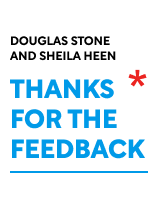

This article is an excerpt from the Shortform book guide to "Thanks for the Feedback" by Douglas Stone and Sheila Heen. Shortform has the world's best summaries and analyses of books you should be reading.
Like this article? Sign up for a free trial here .
Do you have a feedback system at your organization? Do you feel like your employees take on the feedback provided by senior management?
There’s no such thing as a perfect feedback system for any given organization. Every system will have tradeoffs. It will work well for some, be adequate for others, and be poorly suited to still others. There are some things you can do, though, to give your chosen system the best shot at success.
In this article, we’ll examine these techniques through three perspectives: 1) senior leadership and HR, 2) team leaders and coaches, and 3) receivers.
1) Senior Leadership and HR
As the most visible players, a company’s leadership and HR are expected to spearhead performance management systems. Promoting a culture of learning can lay the groundwork and being honest about a system’s benefits and tradeoffs can help smooth a rollout.
Promote a Culture of Learning
As discussed earlier, people who view feedback as an opportunity to learn respond to it better and improve themselves from it more. There are specific things you can do to encourage a culture of learning:
- Highlight journeys of learning: When someone is successful and moves up the ranks, talk about her learning skills—curiosity and openness to feedback, for example—rather than her innate skills like likeability, gregariousness, and intelligence.
- Encourage growth identities: Teach your employees about the differences between growth and fixed identities. Draw the connection between a growth identity and better performance.
- Discuss feedback-receiving methods and “second scores”: Talk about blind spots, triggers, and common misinterpretations. Introduce the concept of grading yourself on how you take feedback.
- Create multiple feedback tracks: Create an official feedback track and a more unofficial one. Track 1 includes performance evaluation systems, mentoring and training programs, and the like. Track 2 encompasses things like informal coaching among friends and colleagues, company stories about success or failure, or an exchange of helpful books.
- Emphasize positive social norms: Highlighting the good things people are doing improves behavior more than highlighting the bad things people do, because the behavior you highlight will be seen as the “norm.” Instead of pointing out that 40 percent of employees still haven’t turned in their self-evaluations, note that 60 percent have, and thank them for doing so. Those who have will feel appreciated, and those who haven’t will feel out of step with their peers.
- Cultivate a culture of shared learning: Promote the idea that “we are all in this together,” and that a well-functioning feedback system benefits everyone, not just the people at the top who are usually the ones giving feedback. Emphasize the learning component of feedback over the evaluation or consequence aspect.
Explain Tradeoffs as Well as Benefits
Often when rolling out a new performance evaluation system, senior leadership and HR extol its benefits in an effort to get the rest of the company behind it. This is an understandable impulse but can have unintended consequences. Employees are quick to pick up on something that sounds too good to be true. If lower-level employees sense their seniors are trying to manipulate their reactions through unrealistic optimism, they’ll react by balancing it with extra skepticism. The company becomes divided into cheerleaders (leadership and HR) and “sneerleaders” (everyone else).
A better approach is one that feels more honest. Promote benefits but also address shortcomings. This will allow employees to be better prepared for how to manage the program and what to expect from it. In particular, address:
- The goals of the system
- The reason this system was chosen over others
- The potential costs as well as benefits
- The consequences of half-hearted participation
- An invitation for further discussion and feedback
Model Receiving Feedback as the Boss
If senior leadership models the feedback-receiving experience, the system will be much more readily accepted across all levels of the organization. It can also be an illuminating exercise for that leadership.
Typically when we ask for feedback, we seek people who are somewhat at the same level of expertise and experience as we are, or ideally, who are ahead of us. Sometimes, though, it’s useful to seek the opinions of those behind us in experience or expertise. Some of the best forms of coaching can actually come from your subordinates, who can see your blind spots and how they affect people at all levels around you. They are hyper-aware of any inconsistencies in your messaging and anything that creates extra work for them.
Actively seek out input from those below you. Establish concrete ways in which people can approach you with insight. Consider establishing “reverse mentorships” with one or more people in several levels of the organization, who you trust to alert you to concerns from different departments or offices of the company. Your goal when seeking feedback as the boss is to discover how your priorities are and aren’t affecting all parts of the organization, and to look out for unintended effects of initiatives.
2) Team Leaders and Coaches
A company is a collection of subcultures. Team leaders can have a significant impact on the productivity and satisfaction of their particular corner of the organization. To ensure effective feedback in the workplace, establish a system, defining the difference between short-term pain and long-term gain, and being aware of individual differences among your teammates.
- Model learning and request coaching: Just as we discussed for senior leadership, it’s crucial for team leaders to show that they, too, are open to learning, not just from those above them but also from peers and subordinates. Make your efforts explicit: encourage your employees to raise issues with you and follow up on their concerns with full discussions using the techniques discussed in this book.
- Distinguish between short- and long-term pain: No one likes to deliver hard news, but sparing someone the unpleasantness of hearing difficult feedback backfires if it causes them to miss out on future opportunities like promotions. Have empathy, but also be clear and honest.
- Be aware of individual differences: Recognize that people have different sensitivities to feedback which can be reflected not only in how they receive feedback but also in how they give it. If you are not very sensitive, you might assume others are equally resilient, but your frank advice might not be taken so well by a more sensitive person. Keep this in mind and encourage those you are coaching to coach your coaching so that you all stay on the same page.
3) Receivers
The most important thing to remember is that as a receiver of feedback, you drive the process and control your own learning. Be proactive—seek out advice from those who can help you. Observe successful people and try to figure out what they’re doing differently. Be open, try out advice, and communicate clearly.
In the end, although learning is a shared experience, your own individual progress is up to you.

———End of Preview———
Like what you just read? Read the rest of the world's best book summary and analysis of Douglas Stone and Sheila Heen's "Thanks for the Feedback" at Shortform .
Here's what you'll find in our full Thanks for the Feedback summary :
- How to better receive feedback, rather than just giving it
- Why people tend to respond negatively towards feedback
- How to successfully incorporate feedback into your life






